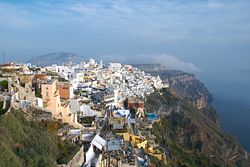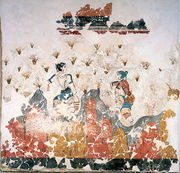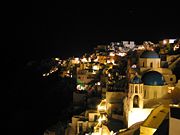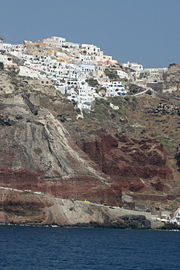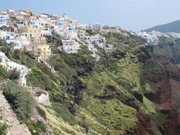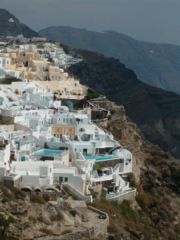Santorini
2008/9 Schools Wikipedia Selection. Related subjects: European Geography
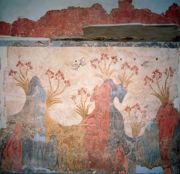
Santorini ( Greek Σαντορίνη, pronounced [ˌsa(n)do̞ˈrini]) is a small, circular archipelago of volcanic islands located in the southern Aegean Sea, about 200 km south-east from Greece's mainland. It is also known as Thera (or Thira, Greek Θήρα [ˈθira]), forming the southernmost member of the Cyclades group of islands, with an area of approximately 73 km² (28 mi²) and a 2001 census population of 13,670. It is comprised of the Municipality of Thíra (pop. 12,440) and the Community of Oía (Οία, pop. 1,230, which includes 268 inhabitants resident on the offshore island of Therasia, lying to the west). These have a total land area of 90.623 km², which also includes the uninhabited islands of Nea Kameni, Palaia Kameni, Aspronisi, and Christiani (all part of the Municipality of Thira).
Santorini is essentially what remains of an enormous volcanic explosion, destroying the earliest settlements on what was formerly a single island, and leading to the creation of the current geological caldera. Its spectacular physical beauty, along with a dynamic nightlife, have made the island one of Europe's tourist hotspots.
A giant central lagoon, more or less rectangular, and measuring about 12 km by 7 km (8 mi by 4 mi), is surrounded by 300 m (984 ft) high steep cliffs on three sides. The island slopes downward from the cliffs to the surrounding Aegean Sea. On the fourth side, the lagoon is separated from the sea by another much smaller island called Therasia; the lagoon merges with the sea in two places, in the northwest and southwest. The water in the centre of the lagoon is nearly 400 m (1300 ft) deep, thus making it a safe harbour for all kinds of shipping. The island's harbours all lie in the lagoon and there are no ports on the outer perimeter of the island; the capital, Fira, clings to the top of the cliff looking down on the lagoon. The volcanic rocks present from the prior eruptions feature olivine and have a notably small presence of hornblende.
It is the most active volcanic centre in the South Aegean Volcanic Arc, though what remains today is chiefly a water-filled caldera. The name Santorini was given it by the Latin empire in the thirteenth century, and is a reference to Saint Irene. Before then it was known as Kallistē ("the most beautiful one"), Strongylē ("the circular one"), or Thera.
The island is the site of one of the largest volcanic eruptions the planet has ever seen: the Minoan eruption (sometimes called the Thera eruption), which occurred some 3,600 years ago at the height of the Minoan civilization. The eruption left a large caldera surrounded by volcanic ash deposits hundreds of feet deep and may have led indirectly to the collapse of the Minoan civilization on the island of Crete, 110 km (70 miles) to the south, through the creation of a gigantic tsunami. Another popular theory holds that the Thera eruption is the source of the legend of Atlantis.
History
Minoan Akrotiri
Excavations starting in 1967 at the site called Akrotiri ("Upper Thira") under the late Professor Spyridon Marinatos have made Thera the best-known "Minoan" site outside of Crete, the homeland of the culture. The island was not known as Thera at this time. Only the southern tip of a large town has been uncovered, yet it has revealed complexes of multi-level buildings, streets, and squares with remains of walls standing as high as eight meters, all entombed in the solidified ash of the famous eruption of Thera. The site was not a palace-complex such as are found in Crete, but its excellent masonry and fine wall-paintings show that this was certainly no conglomeration of merchants' warehousing either. A loom-workshop suggests organized textile weaving for export. This Bronze Age civilization thrived between 3000 to 2000 BC, and reached its peak in the period 2000 to 1580 BC.
Some of the houses in Akrotiri are major structures, some amongst them three stories high. Its streets, squares, and walls were preserved in the layers of ejecta, sometimes as tall as eight meters, and indicating this was a major town. In many houses stone staircases are still intact, and they contain huge ceramic storage jars ( pithoi), mills, and pottery. Noted archaeological remains found in Akrotiri are wall paintings or frescoes, which have kept their original colour well, as they were preserved under many meters of volcanic ash. The town also had a highly developed drainage system and, judging from the fine artwork, its citizens were clearly sophisticated and relatively wealthy people.
Pipes with running water and water closets found at Akrotiri are the oldest such utilities discovered. The pipes run in twin systems, indicating that the Therans used both hot and cold water supplies; the origin of the hot water probably was geothermic, given the volcano's proximity. The dual pipe system suggesting hot and cold running water, the advanced architecture, and the apparent layout of the Akrotiri find resemble Plato's description of the legendary lost city of Atlantis, further indicating the Minoans as the culture which primarily inspired the Atlantis legend.
Fragmentary wall-paintings at Akrotiri lack the insistent religious or mythological content familiar in Classical Greek decor. Instead, the Minoan frescoes depict "Saffron-Gatherers", who offer their crocus-stamens to a seated lady, perhaps a goddess; in another house are two antelopes, painted with a kind of confident, flowing, decorative, calligraphic line, the famous fresco of a fisherman with his double strings of fish strung by their gills, and the flotilla of pleasure boats, accompanied by leaping dolphins, where ladies take their ease in the shade of light canopies, among other frescoes.
The well preserved ruins of the ancient town often are compared to the spectacular ruins at Pompeii in Italy. Unfortunately for would-be visitors the canopy covering the ruins collapsed in September 2005, killing one tourist and injuring seven more. The site remains closed while a new canopy is built.
The oldest signs of human settlement are Late Neolithic ( 4th millennium BC or earlier), but ca. 2000–1650 BC Akrotiri developed into one of the Aegean's major Bronze Age ports, with recovered objects that had come, not just from Crete, but also from Anatolia, Cyprus, Syria, and Egypt as well as from the Dodecanese and the Greek mainland.
Dating
The Minoan eruption provides a fixed point for the chronology of the second millennium BC in the Aegean, because evidence of the eruption occurs throughout the region and the site itself contains material culture from outside. The eruption occurred during the "Late Minoan IA" period at Crete and the "Late Cycladic I" period in the surrounding islands.
The exact date of the eruption, however, is unknown. Radiocarbon dating indicates that the eruption occurred about 1645—1600 BC. These dates, however, conflict with the usual date range from archaeological evidence, which is between about 1550 and 1500 BC. For more discussion, see the article on the Minoan eruption.
Ancient and Medieval Santorini
Santorini remained unoccupied throughout the rest of the Bronze Age, during which time the Greeks took over Crete. At Knossos, in a LMIIIA context (14th century BC), seven Linear B texts while calling upon "all the gods" make sure to grant primacy to an elsewhere-unattested entity called qe-ra-si-ja and, once, qe-ra-si-jo. If the endings -ia[s] and -ios represent an ethnikonic suffix, then this means "The One From Qeras[os]". If aspirated, *Qhera- would have become "Thera-" in later Greek. "Therasia" and its ethnikon "Therasios" are both attested in later Greek; and, since -sos was itself a genitive suffix in the Aegean Sprachbund, *Qeras[os] could also shrink to *Qera. (An alternate view takes qe-ra-si-ja and qe-ra-si-jo as proof of androgyny, and applies this name by similar arguments to the legendary seer, Tiresias, but these views are not mutually exclusive of one another.) If qe-ra-si-ja was an ethnikon first, then in following him/her/it the Cretans also feared whence it came.
Over the centuries after the general catastrophes of 1200 BC, Phoenicians founded a site on Thera. Herodotus reports that the Phoenicians called the island Callista and lived on it for eight generations. Then, in the 9th century BC, Dorians founded the main Hellenic city - on Mesa Vouno, 396 m above sea level. This group later claimed that they had named the city and the island after their leader, Theras.
The Dorians have left a number of inscriptions incised in stone, in the vicinity of the temple of Apollo, attesting to pederastic relations between the authors and their eromenoi. These inscriptions, found by Friedrich Hiller von Gaertringen, have been thought by some archaeologists to be of a ritual, celebratory nature, due to their large size, careful construction and - in some cases - execution by craftsmen other than the authors. Other historians, such as Dover and Henri-Irénée Marrou, have considered them to be pornographic in nature.
According to Herodotus (4.149-165), following a drought of seven years, Thera sent out colonists who founded a number of cities in northern Africa, including Cyrene.
In the 5th century BC, Dorian Thera did not join the Delian League with Athens; and during the Peloponnesian War, Thera sided with Dorian Sparta, against Athens. The Athenians took the island during the war, but lost it again after the Battle of Aegospotami.
As with other Greek territories, Thera then was ruled by the Romans; and it passed to the eastern side of the Empire when it divided - which now is known as the Byzantine Empire.
During the Crusades, the Franks settled it, while in the 13th century AD, the Venetians annexed the isle to the Duchy of Naxos and renamed it "Santorini", that is " Saint Irene". Santorini came under Ottoman rule in 1579.
Modern Santorini
Santorini was united with Greece in 1912. Its major settlements include Fira (Phira), Oia, Emporio, Kamari, Imerovigli, Pyrgos, and Therasia. Akrotiri is a major archaeological site, with ruins from the Minoan era. Santorini's primary industry is tourism, particularly in the summer months. The island's pumice quarries have been closed since 1986, in order to preserve the caldera.
Santorini has no rivers, and water is scarce. Until the early 1990s locals filled water cisterns from the rain that fell on roofs and courts, from small springs, and with imported assistance from other areas of Greece. In recent years a desalination plant has provided running, yet non-potable, water to most houses.
The island remains the home of a small, but flourishing, wine industry, based on the indigenous grape variety, Assyrtiko. Vines of the Assyrtiko variety are extremely old and prove resistant to phylloxera, attributed by local winemakers to the well-drained volcanic soil and its chemistry, and the soil needed no replacement during the great phylloxera epidemic of the early 20th century. In their adaptation to their habitat, such vines are planted far apart, as their principal source of moisture is dew, and they often are trained in the shape of low-spiralling baskets, with the grapes hanging inside to protect them from the winds. Also unique to the island is the red, sweet, and extremely strong Vinsanto. White wines from the island are extremely dry with a strong, citrus scent, and the ashy volcanic soil gives the white wines a slightly sulphurous flavour much like Vinsanto. It is not easy to be a winegrower in Santorini; the hot and dry climatological conditions give the soil a low productivity. The yield per acre is only 10 to 20% of the yields that are common in France and California.
In 1707 an undersea volcano breached the sea surface, forming the current centre of activity at Nea Kameni, and eruptions centred on it continue — the twentieth century saw three such, the last in 1950. At some time in the future, it will almost certainly erupt violently once again. Santorini also was struck by a devastating earthquake in 1956. Although the volcano is at rest at the present time, at the current active crater (there are several former craters on Nea Kameni), steam and sulphur are given off.
Volcanic eruption
The physical eruption
The devastating volcanic eruption of Thera has become the most famous single event in the Aegean before the fall of Troy. This may have been one of the biggest volcanic eruptions on Earth in the last few thousand years.
The violent eruption was centered on a small island just north of the existing island of Nea Kameni in the centre of the caldera; the caldera itself was formed several hundred thousand years ago by collapse of the centre of a circular island caused by the emptying of the magma chamber during an eruption. It has been filled several times by ignimbrite since then, and the process repeated itself, most recently 21,000 years ago. The northern part of the caldera was refilled by the volcano and then collapsed again during the Minoan eruption. Before the Minoan eruption, the caldera formed a nearly continuous ring with the only entrance between the tiny island of Aspronisi and Thera; the eruption destroyed the sections of the ring between Aspronisi and Therasia, and between Therasia and Thera, creating two new channels.
On Santorini, there is to be found a deposit of white tephra thrown from the eruption, lying up to 60 metres thick overlying the soil marking the ground level before the eruption and, forming a layer divided into three fairly distinct bands indicating different phases of the eruption. New archaeological discoveries by a team of international scientists, in 2006, have revealed that the Santorini event was much more massive than previously thought; it expelled 61 km³ of magma and rock into Earth's atmosphere, compared to previous estimates of only 39 cubic kilometres in 1991. Only the Mount Tambora volcanic eruption of 1815 (and possibly the eruption at Lake Taupo of 181 AD) released more material into the atmosphere during the past 5,000 years—at an estimated 100 cubic kilometres.
Speculation on an Exodus Connection
A 2006 documentary created by filmmaker Simcha Jacobovici suggests that the eruption of the Santorini Island volcano (c. 1623 BC, +/-25) caused all the biblical plagues described against Egypt, redating the eruption to c. 1500 BC. The Hyksos, some of them Mycenaean Greek "Hebrews", fled Egypt (which they had in fact ruled for some time) after the eruption. Jacobovici (and fellow producer James Cameron) claim that the Hyksos were none other than the Israelites, who also may have been known as Habiru. The pharaoh with whom they identify the Pharaoh of the Exodus is Ahmose I. Rather than crossing the Red Sea, Jacobovici argued a marshy area in northern Egypt known as the "Reed Sea" would have been alternately drained and flooded by tsunamis caused by the caldera collapse, and could have been crossed during the exodus.
Speculation on an Atlantis connection
It is easy to see why this location was added to the list of possible locations for the fabled city of Atlantis. As with most myths, connections to real places are usually dubious and many scientists often are skeptical. However some archaeological, seismological, and vulcanological evidence (popularized on The History Channel show Lost Worlds episode "Atlantis" ) regarding Crete, Santorini, and the description of Atlantis from Plato has been presented linking the Atlantis myth to Santorini. For more discussion, see the article on Location hypotheses of Atlantis.
